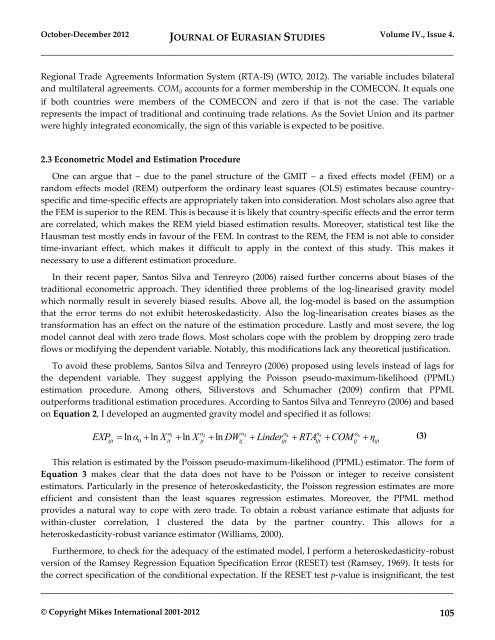Create successful ePaper yourself
Turn your PDF publications into a flip-book with our unique Google optimized e-Paper software.
October-December 2012 JOURNAL OF EURASIAN STUDIES Volume IV., Issue 4.<br />
_____________________________________________________________________________________<br />
Regional Trade Agreements Information System (RTA-IS) (WTO, 2012). The variable includes bilateral<br />
and multilateral agreements. COMij accounts for a former membership in the COMECON. It equals one<br />
if both countries were members <strong>of</strong> the COMECON and zero if that is not the case. The variable<br />
represents the impact <strong>of</strong> traditional and continuing trade relations. As the Soviet Union and its partner<br />
were highly integrated economically, the sign <strong>of</strong> this variable is expected to be positive.<br />
2.3 Econometric Model and Estimation Procedure<br />
One can argue that – due to the panel structure <strong>of</strong> the GMIT – a fixed effects model (FEM) or a<br />
random effects model (REM) outperform the ordinary least squares (OLS) estimates because countryspecific<br />
and time-specific effects are appropriately taken into consideration. Most scholars also agree that<br />
the FEM is superior to the REM. This is because it is likely that country-specific effects and the error term<br />
are correlated, which makes the REM yield biased estimation results. Moreover, statistical test like the<br />
Hausman test mostly ends in favour <strong>of</strong> the FEM. In contrast to the REM, the FEM is not able to consider<br />
time-invariant effect, which makes it difficult to apply in the context <strong>of</strong> this study. This makes it<br />
necessary to use a different estimation procedure.<br />
In their recent paper, Santos Silva and Tenreyro (2006) raised further concerns about biases <strong>of</strong> the<br />
traditional econometric approach. They identified three problems <strong>of</strong> the log-linearised gravity model<br />
which normally result in severely biased results. Above all, the log-model is based on the assumption<br />
that the error terms do not exhibit heteroskedasticity. Also the log-linearisation creates biases as the<br />
transformation has an effect on the nature <strong>of</strong> the estimation procedure. Lastly and most severe, the log<br />
model cannot deal with zero trade flows. Most scholars cope with the problem by dropping zero trade<br />
flows or modifying the dependent variable. Notably, this modifications lack any theoretical justification.<br />
To avoid these problems, Santos Silva and Tenreyro (2006) proposed using levels instead <strong>of</strong> lags for<br />
the dependent variable. They suggest applying the Poisson pseudo-maximum-likelihood (PPML)<br />
estimation procedure. Among others, Siliverstovs and Schumacher (2009) confirm that PPML<br />
outperforms traditional estimation procedures. According to Santos Silva and Tenreyro (2006) and based<br />
on Equation 2, I developed an augmented gravity model and specified it as follows:<br />
α1 α2 α3 α4<br />
α5 α6<br />
EXP ln α ln X ln X ln DW Linder RTA COM η<br />
(3)<br />
ijt 0 it jt ij ijt ijt ij ijt<br />
This relation is estimated by the Poisson pseudo-maximum-likelihood (PPML) estimator. The form <strong>of</strong><br />
Equation 3 makes clear that the data does not have to be Poisson or integer to receive consistent<br />
estimators. Particularly in the presence <strong>of</strong> heteroskedasticity, the Poisson regression estimates are more<br />
efficient and consistent than the least squares regression estimates. Moreover, the PPML method<br />
provides a natural way to cope with zero trade. To obtain a robust variance estimate that adjusts for<br />
within-cluster correlation, I clustered the data by the partner country. This allows for a<br />
heteroskedasticity-robust variance estimator (Williams, 2000).<br />
Furthermore, to check for the adequacy <strong>of</strong> the estimated model, I perform a heteroskedasticity-robust<br />
version <strong>of</strong> the Ramsey Regression Equation Specification Error (RESET) test (Ramsey, 1969). It tests for<br />
the correct specification <strong>of</strong> the conditional expectation. If the RESET test p-value is insignificant, the test<br />
_____________________________________________________________________________________<br />
© Copyright Mikes International 2001-2012 105

















